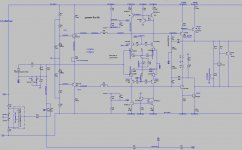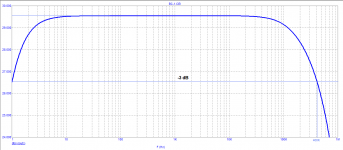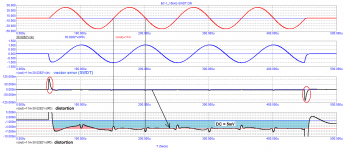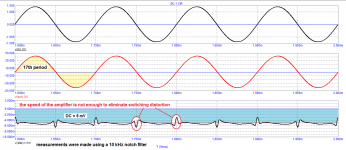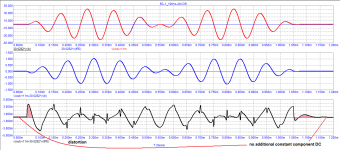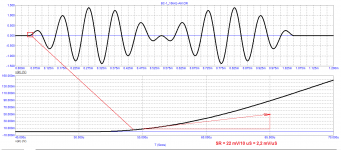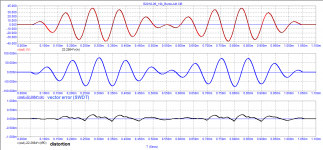Better watch out. He's already typing in PGP schematics in to his simulator.
I’m scared, I’m very scared.
For a music or any other real audio signal, there is no first cycle etc, because real audio is not the product of a linear signal and a rectangular gating pulse. It may be gated once by a mute function and minutes later, it is still on and all out-of-band signals are history, not part of the audio presentation. The recording process removes any out-of-band signal, so that task does not fall to the amplifier.
What out-of-band distortion are you talking about?
Here I showed that the distortion of a signal with a frequency of 20 Hz up to the 10th harmonic (in the band up to 200 Hz) measured in the steady state is negligible - only 0.000002%.
https://www.diyaudio.com/community/threads/bob-cordells-power-amplifier-book.171159/post-6949029
And here I showed that the same 20 Hz in the same 200 Hz band but on the 2nd period have distortions of 0.35% and decrease to 0.025% on the 10th period.
https://www.diyaudio.com/community/threads/bob-cordells-power-amplifier-book.171159/post-6949480
Hello JanHow this makes me feel:
'Would you please spend an hour or so of your spare time for this?'
I couldn't spare a few minutes to make it easier for you.
YMMV
Jan
You made two good points here.
I must assure you that It was never my intention to be rude or abuse Bob`s time.
Now I understand why I did not receive any other feedback.
I prepared a new simulation with some refinements hoping for a brief comment.
Hello Bob and Jan
I prepared two asc files that should run as I included the models directly in the asc file.
This time I increased the floating ccs current and added R12 and R57 (150k ohm) so not to reduce OLG at LF.
Let me remind you that the amplifier is built and works perfectly with Bob`s shunt resistors solution but I feel I could get a slight improvement in the LF if I was able to increase OLG.
As is the amplifier produces an extremely detailed and clear HF being able to produce a very large and well defined soundstage but the competitor (my reference in fact based on the differential VAS also from Bob`s book) has a much better rendition in the lower octaves.
Hope you have the amiability to have a look at my humble efforts.
Best regards
Ricardo
I prepared two asc files that should run as I included the models directly in the asc file.
This time I increased the floating ccs current and added R12 and R57 (150k ohm) so not to reduce OLG at LF.
Let me remind you that the amplifier is built and works perfectly with Bob`s shunt resistors solution but I feel I could get a slight improvement in the LF if I was able to increase OLG.
As is the amplifier produces an extremely detailed and clear HF being able to produce a very large and well defined soundstage but the competitor (my reference in fact based on the differential VAS also from Bob`s book) has a much better rendition in the lower octaves.
Hope you have the amiability to have a look at my humble efforts.
Best regards
Ricardo
Attachments
Sometimes people at a distance see more than close-up.Hello Jan
You made two good points here.
I must assure you that It was never my intention to be rude or abuse Bob`s time.
Now I understand why I did not receive any other feedback.
I prepared a new simulation with some refinements hoping for a brief comment.
I'm sure it wasn't intentional, but it can come over negatively.
Thanks,
Jan
For a music or any other real audio signal, there is no first cycle etc, because real audio is not the product of a linear signal and a rectangular gating pulse. It may be gated once by a mute function and minutes later, it is still on and all out-of-band signals are history, not part of the audio presentation. The recording process removes any out-of-band signal, so that task does not fall to the amplifier.
well, but such signals are possible in musical signals? one - multitone 10 + 9 kHz, the second 10 kHz with amplitude modulation 1 kHz. Both are passed through a 100 kHz low-pass filter.
I think you still don't grasp that discontinuities (first or second order) are not part of a band-limited signal, since discontinuities have infinite spectra. This is a simple mathematical fact.
If you expect any system to accurately reproduce a discontinuous signal (or one with HF components well outside its nominal band), it will fail, but this is nothing to do with its actual distortion performance with genuinely in-band signals.
If you expect any system to accurately reproduce a discontinuous signal (or one with HF components well outside its nominal band), it will fail, but this is nothing to do with its actual distortion performance with genuinely in-band signals.
If I remember correctly, a 100kHz low pass was used pretending that it would limit the signal frequencies to the audio band.
But that is not at all the case; with a 100kHz 1st order low pass, the 200kHz component is only 6dB or so below the 100kHz component.
Hitting an audio amp with such a signal is very unfair to the amp 😎
And drawing conclusions from how the amp handles this for it's performance in the audio band can be very misleading. Bad science.
Jan
But that is not at all the case; with a 100kHz 1st order low pass, the 200kHz component is only 6dB or so below the 100kHz component.
Hitting an audio amp with such a signal is very unfair to the amp 😎
And drawing conclusions from how the amp handles this for it's performance in the audio band can be very misleading. Bad science.
Jan
I think you still don't grasp that discontinuities (first or second order) are not part of a band-limited signal, since discontinuities have infinite spectra. This is a simple mathematical fact.
If you expect any system to accurately reproduce a discontinuous signal (or one with HF components well outside its nominal band), it will fail, but this is nothing to do with its actual distortion performance with genuinely in-band signals.
I agree with you, every note of a piece of music begins with a break of the first or second order.
Hit the piano key - get an infinite spectrum. Hit the cymbal with a stick - get another portion of the infinite spectrum, and so on from the beginning to the end of the piece of music.
And in order to reliably amplify such signals, the amplifier must be as broadband as possible, strictly speaking - with an infinite bandwidth.
For example, Hafler said that the amplifier should be as broadband as possible, although I have not seen anywhere in his statements which band is enough. Cyril Hammer argued that an amplifier with feedback should have a negligible signal propagation delay - only a few ns, and this requires a bandwidth of tens of MHz.
The low-signal bandwidth of the amplifier under consideration is 400 kHz, while the full power bandwidth is much more modest.
Attachments
Hit the piano key - get an infinite spectrum. Hit the cymbal with a stick - get another portion of the infinite spectrum...
The claims quoted above are not true in the physical world. Its only true as some kind of rough mathematical approximation.
You appear to be confusing mathematical approximation with physical reality.
Fully agree. For this to happen, the vibrating material of the instrument would have to start vibrating to its nominal value within zero time, which would require infinite acceleration.The claims quoted above are not true in the physical world. Its only true as some kind of rough mathematical approximation.
You appear to be confusing mathematical approximation with physical reality.
Not in our physical world!
Jan
Fully agree. For this to happen, the vibrating material of the instrument would have to start vibrating to its nominal value within zero time, which would require infinite acceleration.
Not in our physical world!
Jan
Jan, where do you see the infinite slew rate? at what point of the signals? Can you show these points in a stretched form?
Here are three tests with a 10 kHz signal:
- In steady state - using a 10 kHz notch filter;
- With the help of a burst (the test was performed in a compensatory way);
- With the help of an amplitude-modulated signal (the test was performed in a compensatory way).
All three tests were carried out on the same model by simply switching the input signal. In the absence of an input signal, the output of the amplifier has a DC component of approximately 11 mV.
All three tests were carried out on the same model by simply switching the input signal. In the absence of an input signal, the output of the amplifier has a DC component of approximately 11 mV.
When a burst is applied to the input (the first test), reaching the steady state takes a little more than a period (not counting the additional constant component in the signal).
When applying an amplitude-modulated signal, the greatest distortion occurs precisely at small signal amplitudes.
In the third figure, areas of distortion with an “infinite spectrum” are highlighted in pink (if I understand your statement correctly).
Attachments
It that were really true there would be singularities in the physics, which is not the case. However what does happen is very wide spectrum generated with the impact events as there are some short time-constants involved - in otherwords some ultrasonic components.I agree with you, every note of a piece of music begins with a break of the first or second order.
However the air then low-pass filters this somewhat (ultrasound is attenuated more at higher frequencies), but this is likely not significant for most musical sound sources (this is in the MHz and above IIRC).
But the microphone, input preamp and associated circuitry recording the event are band limited and all those transient features get strongly low pass filtered, and also the recording medium (beit analog or digital) again is band-limited. All these systems are effectively low pass filters with lots and lots of poles due to all sorts of physical and electronic time-constants built into their physics. Thus you end up with only a low level ultrasonic tail of response extending past 20kHz, and no more discontinities (except when plugging plugs ad switching switches perhaps).
So these high frequency transients are gone long before the amp gets to see them when playing back the music.
Note the ear does exactly the same thing and low pass filters transients away as it too strongly low-pass filters with many mechanical poles to the response corresponding to the inertial response of moving parts.
So the notion that distortions outside the audio band being important for an amp is misguided - the ear cannot hear it, the incoming signals are band limited anyway, all this first-cycle stuff with transients is not going to be happening in sound reproduction from real recordings, and if you expect initial transients to be reproduced perfectly you are asking the physically impossible - what you are really asking for is for a very wide bandwidth far into the ultrasonic - why? Why would you want this? Its like wanting your TV screen to accurately reproduce UV, X-rays and gamma-rays experienced by the camera.
I thought FCDeers and their delusion were privileged a special space called "musing pit" to ferment……?
https://en.wikipedia.org/wiki/Window_function
Note that the derivative of the slew rate, aka 2nd derivative, is also limited to a non-infinite value.
Also, musical instruments are not made of diamond hard materials. Percussion instruments deform on impact before they begin to vibrate. Even granite "bends" to some degree. See "hardness tester".
Note that the derivative of the slew rate, aka 2nd derivative, is also limited to a non-infinite value.
Also, musical instruments are not made of diamond hard materials. Percussion instruments deform on impact before they begin to vibrate. Even granite "bends" to some degree. See "hardness tester".
Last edited:
Another fine thread on the course of being ruined by fanatical believer. Yes, believer as whatever Petr presents has no support in theory and is sourced only from what he believes.
The Church of Holly First Cycle
In years of harassing various threads on this forum, he failed to learn anything and failed to provide any evidence in support of his claims. He lives in the alternate reality where universe laws are of no consequence.
Don't feed the ....
The Church of Holly First Cycle
In years of harassing various threads on this forum, he failed to learn anything and failed to provide any evidence in support of his claims. He lives in the alternate reality where universe laws are of no consequence.
Don't feed the ....
Theory is presented in a short article:
https://www.diyaudio.com/community/...nterview-negative-feedback.94676/post-6925975
But it is useless to give it to the blind to read, or to explain anything in plain language to the deaf.
Bob, why did I ask you a question about your opinion about the signal delay time? Because this topic is not covered in any book on the design of audio frequency amplifiers.
Here are the same tests that I gave on the model of your VS-1 amplifier on the model of another amplifier whose signal delay time is an order of magnitude less. Distortions in steady state are approximately comparable.
Compare and draw conclusions.
Thanks for attention
https://www.diyaudio.com/community/...nterview-negative-feedback.94676/post-6925975
But it is useless to give it to the blind to read, or to explain anything in plain language to the deaf.
Bob, why did I ask you a question about your opinion about the signal delay time? Because this topic is not covered in any book on the design of audio frequency amplifiers.
Here are the same tests that I gave on the model of your VS-1 amplifier on the model of another amplifier whose signal delay time is an order of magnitude less. Distortions in steady state are approximately comparable.
Compare and draw conclusions.
Thanks for attention
Attachments
I think that's extrapolating beyond available data. We still don't fully understand how the ear works. It's a non-linear statistical system.Note the ear does exactly the same thing and low pass filters transients away as it too strongly low-pass filters with many mechanical poles to the response corresponding to the inertial response of moving parts.
But I can tell you that there are auditory neurons exclusively tuned for transients and they have dentritic trees that extend across the entire audio band. Just a imagine someone creeping up behind you and accidentally stepping on a twig in the forest; if you don't react quickly you're dead. Same with some kind of predatory animal such as a tiger sneaking up on you lol. So there is plenty of natural selection for this kind of auditory capability.
Why does this thread have to be polluted with this nonsense? Seriously, people come here specifically to ask BC questions about his book and/or get some advice. You already have a thread on this.
- Home
- Amplifiers
- Solid State
- Bob Cordell's Power amplifier book
